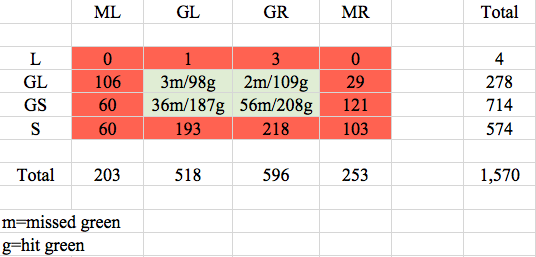Actually yesterday’s. I spent the day thinking about it. I played nine holes, and was two over par for six of them, and seven over, two doubles and a triple, for the other three. That will make you think.
Now there is no “if only” in sports. I shot what I shot. But looking over those three high scores, the pattern was that I lost four strokes because of bad decisions. The problem is that I have forgotten how to play golf.
Playing golf is not about hitting good shots. I can do that. Golf is about hitting as few of them as possible, and that’s a different skill.
So let me go over my errors with you so you can see if that will help you start thinking about how to shoot a lower score with the same skills.
The 5th hole is 505 yards long. A drive and a hybrid put me right in front of a wide-open green, between an eight and nine-iron. I chose the eight because I always want to have enough club in my hand. So far, so good. But I forgot what you do when you choose the longer club: grip down and swing fully. Gripping down takes about five yards off the shot. Instead I tried swinging a little easier, which makes bad things happen, and sure enough, I chunked it.
The ball was close enough to the green that par was still in play if I could chip on and sink the putt. But I forgot the Maxim of the Short Game: just get the ball on the green so you can start putting. I got too cute with the chip by going for the pin instead of the green and chunked it. One chip and two putts later, I’m in the hole with a DB.
The very next hole, a long par 4 into the wind, was a bogey hole that day. A drive and a seven-iron later I’m close to the green. Simple pitch, two putts, maybe one, and I’m happy. But I forgot to check the distance to the pin. Because of the wind I chose a stronger club to pitch with, but the pin was too close even for that, and I flew the green with my pitch. It took me three shots to get down chipping to a green sloping away from me. DB.
Three holes later, the ninth, I hit my drive into the right rough. I had been pushing my driver all day, but getting away with it. The ground rises dramatically to the green, and given my lie I didn’t want to try for the green, come up short, and end up with the ball on a severe upslope. So I played short, leaving the ball on a moderate upslope, which was all I could do.
This time I checked the distance to the pin, but didn’t evaluate the situation correctly. When you pitch off an uphill lie, the slope adds loft to the club. You have to club down to hit the ball the same distance. But I started my calculation with the club I should have ended up with, and once again had too much club in my hand. The pitch flew the green into a bad place and it took me four to get down from there. TB.
Three bad decisions cost me four strokes. I ended up with a 45 that could have been a 41 without playing any better, but just by thinking more clearly.
That’s how this game goes. This is clear evidence of what I call the Floyd Rule, which I take from Raymond Floyd’s book, The Elements of Scoring, and that is, “If I were given your physical game, and we had a match, I would beat you 99 times out 100 times because I know how to play the game better than you do.”
Let me give you one more example from that day’s round, by one of my playing partners. On the eighth hole, we both put our tee shots in the right rough (I ended up with a par). His ball was right behind a small tree trunk with about four inches to spare. He had the easiest shot in the world to chip 90 degrees back into the fairway so he could hit on.
What did he do? He gripped down and tried to hit the ball in the direction of the green, or as nearly as he could. With a swing featuring a four-inch follow-through, he bladed the ball about 15 feet and deeper into the rough. Oh, well…
So my question to you is, do you think about your mistakes? Write them down? Learn from them, so next time you know what to do? Not just think, “Why did I do that,” but know now what you should have done, and next time apply the correction?
I truly believe that if you concentrated only on playing the game better you could reduce your average score by over five percent. That doesn’t sound like a lot, but do the math.
Hint: most mistakes come from getting greedy. We won’t concede one lost stroke and end up taken two or three more instead.




